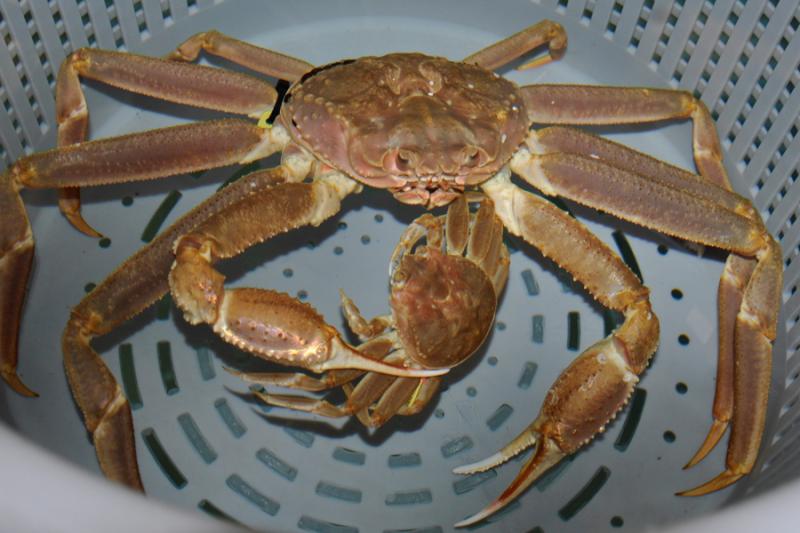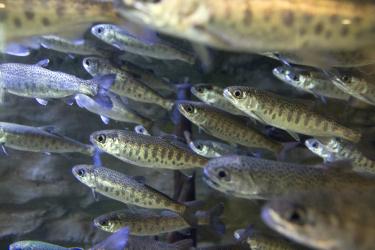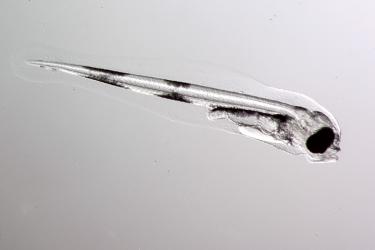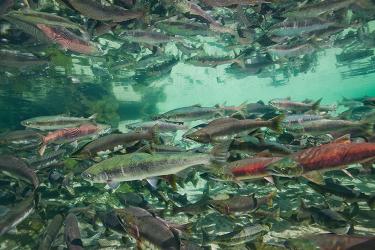As carbon emissions continue to acidify our oceans, some marine species will adapt. Others are already struggling. New research suggests that commercially important Alaska snow crab may already be well-adapted to survive levels of acidity predicted 200 years into the future.
NOAA Fisheries’ Alaska Fisheries Science Center biologists led a team of experts in the first research to look at impacts of ocean acidification on snow crab. The team conducted laboratory experiments evaluating long-term effects on multiple states of the crab lifecycle including embryos, larvae, and adults. They found that no life stage was adversely affected by levels of acidity that the Bering Sea is predicted to reach over the next two centuries.
“It’s exciting to get a different answer than you expected,” said study leader Chris Long, NOAA Fisheries, Alaska Fisheries Science Center. “We’ve found many marine species, including some other crab species in Alaska, to be vulnerable to acidification. Snow crab seem to be resilient. It’s good news for the first time.”
Ocean Acidification and Alaska Seafood
In recent decades, emissions from human activities have increased levels of carbon dioxide in the atmosphere. The ocean absorbs about 30 percent of the carbon we emit—but becomes more acidic in the process. If carbon dioxide levels continue to rise as predicted, global oceans will become more acidic over coming centuries.
Acidification reduces survival of many marine species. It can also slow growth, dissolve shells and skeletons, reduce hatching success, and impair larval development. Adverse effects have been reported for many commercial shellfish such as mussels, oysters, and crab.
High-latitude seas absorb carbon dioxide more easily and therefore acidify faster than warmer waters. The subarctic Bering Sea’s frigid temperatures and particular water chemistry make it especially susceptible.
The Bering Sea produces some of the world’s largest seafood harvests. Snow crab is one of several economically important crab species that inhabit these waters. During some years in the 1990s, eastern Bering Sea snow crab accounted for more than one-third of the total value of landings in all U.S commercial crab fisheries. NOAA Fisheries, the North Pacific Fishery Management Council, and the Alaska Department of Fish and Game co-manage the Alaska snow crab fishery.
“Understanding how changing emissions affect commercial resources is critical to support sustainable management. If we know that ocean acidification is going to cause lower survival or growth, that means less production, so you have to adjust the harvest,” Long said. “Our job is to maximize what fishermen can harvest from these stocks—while making sure that they will still be there the next time and for the next generation.”
Understanding Impacts of Ocean Acidification on Alaska Crabs
Over the past decade Center biologists have conducted laboratory experiments to evaluate acidification impacts on commercial crab species in Alaska: red, blue, and golden king crab; and southern Tanner crab. All were adversely affected by acidification.
Impacts on Tanner crab were particularly dire. Acidification altered development, reduced growth, and increased mortality. It softened claws and eroded shells from the inside. Hatching success plummeted by more than 70 percent.
“Our next question was, what about snow crab? We know Tanner and snow crab are very similar. They’re in the same genus. Their habitat overlaps. They can even produce hybrid offspring,” Long said. “We feared that the two species would be similarly vulnerable to acidification.”
Measuring Effects Across Snow Crab Life Stages
To understand environmental influences on crab populations, it is essential to look across their life cycle. Crab larvae hatch from embryos and pass through three planktonic larval stages. The last stage settles to the bottom and metamorphoses to the juvenile stage. Juveniles molt through more stages before reaching maturity. Each life stage has its own physiology, habitat, and diet—and potential vulnerability to acidification.
“Even if acidification doesn’t impact one life stage, it may affect other life stages of the same species,” Long said.
To begin the laboratory experiments, mature female snow crabs were collected during Alaska Fisheries Science Surveys and by fishermen. Females were held at the Alaska Fisheries Science Center’s Kodiak Laboratory for 2 years in seawater acidified to levels expected over the next two centuries. Their first brood of eggs hatched during the first year. Then each female was provided with a male to mate with. They produced another clutch of eggs that hatched during the second year. Larvae that hatched were used in experiments to determine the effects of acidification on them.
The scientists monitored embryo development, hatching success, and larval development. At the end of the experiment, they examined the shells of adult females for damage.
Long-Term Experiments Key to Strong Science
Long underscored the importance of long-term experiments in fully assessing effects of acidification on crab.
“It is very rare to do experiments this long, but it is critical to fully assessing effects of acidification,” Long said. “With a shorter experiment, we would have to ask: what if we kept them longer?”
Long points out that acidification didn’t show much effect on Tanner crab hatching success until the second year of the experiments.
“During the first year in the laboratory, females are cooking up new batches of eggs under elevated acidification. It wasn’t until the second year, when those eggs hatched, that we saw negative effects on hatching success,” Long said. “Without running the experiment that long, you couldn’t see that effect.”
Snow crab is a long-lived species. Males have an estimated lifespan of 14 to 16 years; females, 11 to 12 years. That makes long-term exposure especially important for assessing cumulative effects of acidification on the integrity of their shells.
“When we didn’t see any effects on shells after 2 years, we could be pretty confident of those results,” Long said.
Partnerships Essential to Success
From fishermen providing crabs for experiments, to scientists providing unique skills and capabilities, partnerships made the research possible.
The team brought together diverse capabilities and expertise to accomplish what none of them could do alone.
“A big example was looking at acidification effects on the shells of females,” Long said. “Our colleague at the College of New Jersey used to work on human teeth. Now he applies that knowledge to animals. He measured the properties of the shells and how their integrity was affected. He determined how damage could impair activities crucial to survival: feeding, defense, and locomotion. There aren’t many other people who could have done this.”
New Possibilities for Understanding Adaptation
The new findings are valuable information for fishery managers and fishing communities preparing for future changes. They also open new possibilities to understanding how species adapt to ocean acidification.
“Ocean pH doesn’t change overnight. It’s a decades-long process. There is time for adaptation,” Long said. “We’ll now be able to compare snow crab and Tanner crab. We can identify mechanisms for adaptation in snow crab. Do Tanner crab have some of these? That could change the answer to how many Tanner crab are going to be out there in the future.”
Future Challenges
Currently the team is evaluating acidification effects on one last snow crab life stage—juveniles.
“Our results so far suggest that juveniles may be even less sensitive than other stages,” Long said.
But Long cautions that there is more to the story than acidification alone.
“We’re not off the hook yet. Ocean acidification is not the only thing that is changing. Our findings are good news for snow crab, but we have to keep looking at other things – like temperature, that's the big one.”
The team is currently running experiments to see if the interaction of increased temperature on top of acidity affects survival, beginning with adult crabs.
Rising heat, melting sea ice, and ocean acidification pose threats to many marine species. In recent years the southeastern Bering Sea snow crab population plummeted in the wake of unprecedented warming and loss of sea ice that leaves them vulnerable to predation.
“Snow crab face a lot of challenges in the coming years,” Long said. “But ocean acidification may be one thing we don’t need to worry about.”









